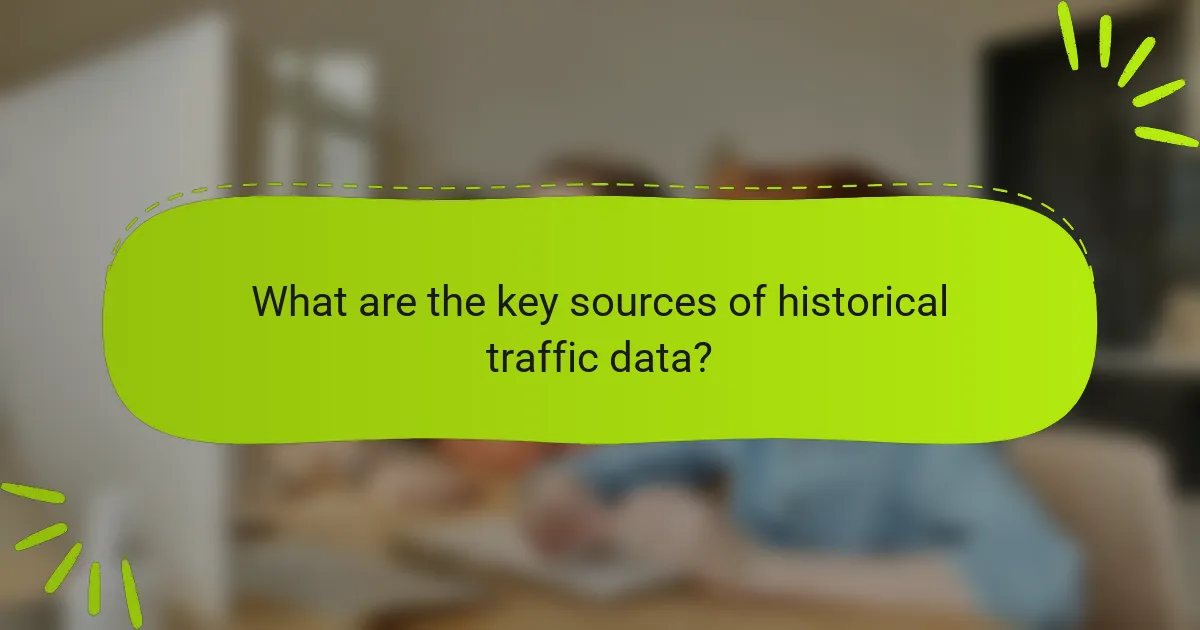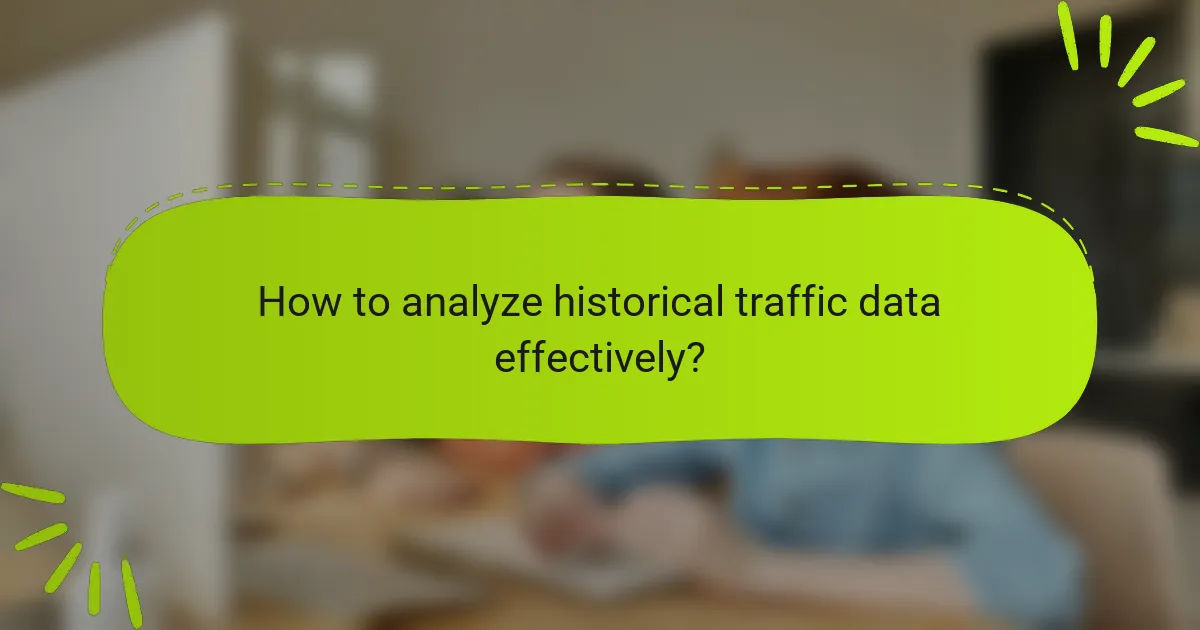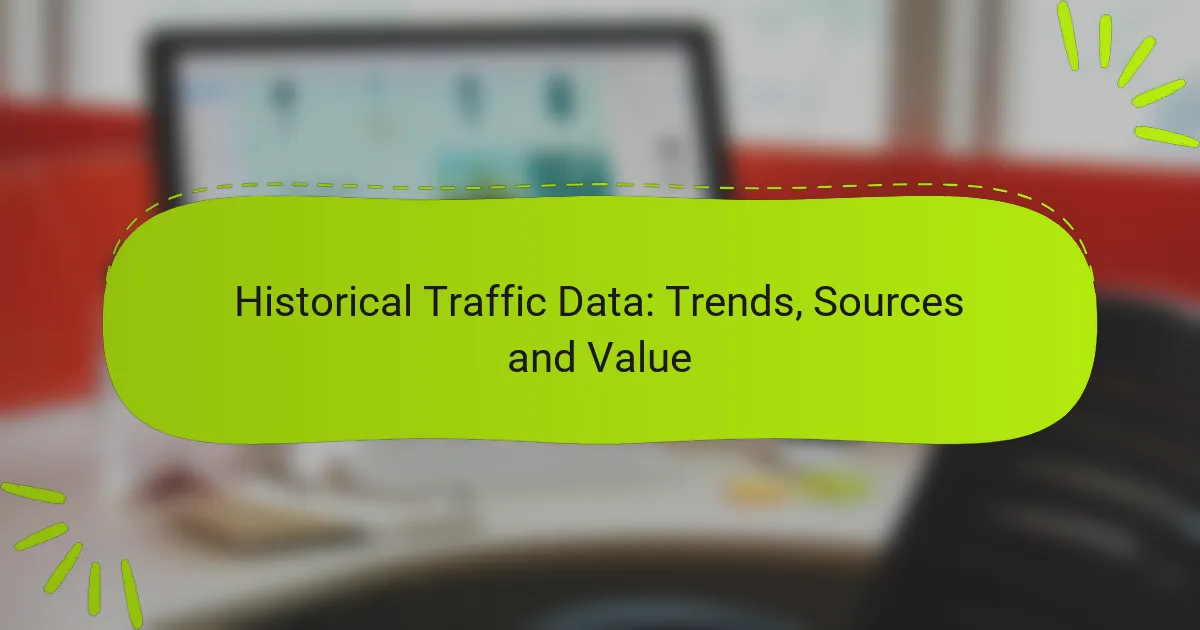Historical traffic data plays a crucial role in shaping effective advertising strategies by offering valuable insights into consumer behavior and trends. By examining past traffic patterns, businesses can make data-driven decisions on resource allocation to optimize their marketing efforts. Key sources of this data, such as web analytics and social media insights, provide a comprehensive view of user engagement and traffic dynamics, enabling companies to identify significant trends and adapt their strategies accordingly.

How can historical traffic data inform advertising strategies in Palau?
Historical traffic data can significantly enhance advertising strategies in Palau by providing insights into consumer behavior and trends. By analyzing past traffic patterns, advertisers can make informed decisions about where and when to allocate their resources for maximum impact.
Optimizing ad placements
Using historical traffic data allows advertisers to identify the most effective locations for ad placements. By analyzing which areas have historically attracted more foot traffic, businesses can position their ads in high-visibility spots, increasing the likelihood of engagement.
For instance, if data shows that a particular street sees a surge in visitors during weekends, placing ads there during that time can lead to better results. Regularly reviewing and adjusting placements based on updated traffic data is essential for ongoing optimization.
Targeting audience segments
Historical traffic data can help advertisers understand different audience segments and their behaviors. By segmenting traffic data based on demographics or interests, businesses can tailor their advertising messages to resonate with specific groups.
For example, if data indicates that younger audiences frequent certain areas more often, advertisers can create campaigns that appeal specifically to that demographic, enhancing relevance and engagement.
Enhancing campaign performance
Analyzing historical traffic data can lead to improved campaign performance by allowing advertisers to test and refine their strategies. By reviewing past campaigns and their outcomes, businesses can identify what worked well and what didn’t.
Implementing A/B testing based on historical insights can help in fine-tuning ad content, visuals, and calls to action, ultimately leading to higher conversion rates.
Improving ROI
Investing in advertising without understanding traffic data can lead to wasted resources. Historical traffic data helps in calculating return on investment (ROI) more accurately by linking ad spend to actual traffic and sales conversions.
By focusing on high-traffic areas and times, businesses can maximize their advertising budget and achieve a better ROI. Regularly analyzing the effectiveness of campaigns against traffic data ensures ongoing financial efficiency.
Identifying peak traffic times
Understanding peak traffic times is crucial for effective advertising. Historical traffic data reveals when specific locations experience the highest visitor numbers, enabling advertisers to time their campaigns for maximum visibility.
For example, if data shows that a local market is busiest on Saturday mornings, businesses can schedule their promotions or events during that time to capture more attention and drive sales. Monitoring these trends regularly allows for timely adjustments to advertising strategies.

What are the key sources of historical traffic data?
Key sources of historical traffic data include web analytics platforms, social media insights, server logs, and third-party analytics tools. Each source provides unique insights into user behavior, traffic patterns, and engagement metrics that can inform business strategies.
Google Analytics
Google Analytics is a widely used platform that tracks and reports website traffic. It provides detailed insights into user demographics, behavior, and acquisition channels, allowing businesses to understand how visitors interact with their site.
To effectively utilize Google Analytics, set up goals and conversion tracking to measure specific actions, such as purchases or sign-ups. Regularly review the data to identify trends and adjust marketing strategies accordingly.
Social media insights
Social media platforms like Facebook, Twitter, and Instagram offer built-in analytics tools that provide data on user engagement, reach, and demographics. These insights help businesses understand how their content performs across different channels.
When analyzing social media insights, focus on metrics such as engagement rates and audience growth. This information can guide content creation and promotional strategies to enhance visibility and interaction.
Website server logs
Website server logs record all requests made to the server, including page views, user IP addresses, and timestamps. Analyzing these logs can reveal patterns in traffic, peak usage times, and potential security issues.
To make the most of server logs, consider using log analysis tools that can visualize data trends. This can help identify high-traffic pages and optimize server performance during peak times.
Third-party analytics tools
Third-party analytics tools, such as Adobe Analytics or Matomo, offer advanced tracking and reporting capabilities beyond what standard platforms provide. These tools can integrate with various data sources to give a comprehensive view of user interactions.
When choosing a third-party tool, evaluate features such as real-time data processing and customization options. Ensure the tool aligns with your specific analytics needs and budget constraints for optimal results.

What trends can be identified from historical traffic data?
Historical traffic data reveals significant trends that can inform future strategies. Key trends include seasonal fluctuations, the effects of marketing campaigns, shifts in user behavior, and the emergence of new traffic sources.
Seasonal traffic fluctuations
Seasonal traffic fluctuations are predictable changes in visitor numbers based on the time of year. For example, e-commerce sites often see increased traffic during the holiday season, while travel-related sites may peak in summer months.
Understanding these patterns allows businesses to optimize their marketing efforts and inventory management. Companies can prepare for high traffic periods by ramping up server capacity and staffing levels to handle increased demand.
Impact of marketing campaigns
Marketing campaigns can significantly influence traffic trends, often resulting in noticeable spikes during promotional periods. For instance, a well-timed social media campaign can drive traffic increases of 20-50% compared to regular periods.
To maximize the impact of marketing efforts, businesses should analyze past campaigns to identify what strategies were most effective. This includes assessing the timing, channels used, and audience engagement levels.
User behavior changes
User behavior changes can alter traffic patterns over time, influenced by factors such as technology advancements or shifts in consumer preferences. For example, the rise of mobile browsing has led to increased traffic from smartphones and tablets.
Monitoring these changes is crucial for adapting marketing strategies and website designs. Businesses should regularly review analytics to understand how user preferences evolve and adjust their approaches accordingly.
Emerging traffic sources
Emerging traffic sources, such as social media platforms and referral sites, can significantly impact overall traffic trends. As new platforms gain popularity, they can drive substantial traffic to websites, often surpassing traditional sources like search engines.
To leverage these emerging sources, businesses should diversify their marketing strategies and explore partnerships with influencers or content creators on these platforms. Regularly updating traffic source analysis can help identify new opportunities for growth.

How to analyze historical traffic data effectively?
To analyze historical traffic data effectively, focus on identifying trends over time and understanding the factors influencing those trends. This involves collecting data from reliable sources and utilizing analytical tools to derive actionable insights.
Using data visualization tools
Data visualization tools are essential for interpreting historical traffic data. They help transform complex datasets into clear, visual formats such as graphs and charts, making it easier to spot trends and anomalies. Popular tools include Tableau, Google Data Studio, and Microsoft Power BI.
When using these tools, consider the type of data you have and the story you want to tell. For instance, line graphs are great for showing trends over time, while bar charts can effectively compare traffic volumes across different periods or sources. Ensure your visuals are straightforward and avoid clutter to maintain clarity.
Segmenting traffic by source
Segmenting traffic by source allows for a more nuanced analysis of historical data. By categorizing traffic into sources such as organic search, paid ads, social media, and direct visits, you can identify which channels are most effective and where improvements are needed.
To segment effectively, use analytics tools like Google Analytics, which can automatically categorize traffic sources. Regularly review these segments to adjust marketing strategies and allocate resources efficiently. For example, if social media traffic is significantly lower than expected, consider increasing your engagement efforts on those platforms.
